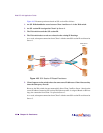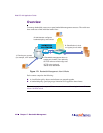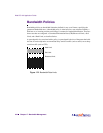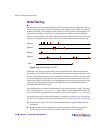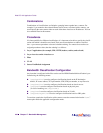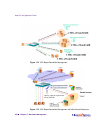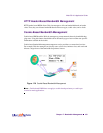
Web OS 10.0 Application Guide
446
Chapter 17: Bandwidth Management
212777-A, February 2002
Data Pacing
The mechanism used to keep the individual traffic flows under control is called data pacing. It
is based on the concept of a virtual clock and theoretical departure times (TDT). The actual cal-
culation of the TDT is based initially on the soft limit rate. The soft limit can be thought of as a
target limit for the ISP’s customer. So long as bandwidth is available and the classification
queue is not being filled at a rate greater than the soft limit, the TDT will be met for both incom-
ing frames and outgoing frames and no borrowing or bandwidth limitation will be necessary.
Figure 17-3 Virtual Clocks and TDT
If the data is arriving more quickly than it can be transmitted at the soft limit and sufficient
bandwidth is still available, the rate is adjusted upwards based on the depth of the queue, until
the rate is fast enough to reduce the queue depth or the hard limit is reached. If the data cannot
be transmitted at the soft limit, then the rate is adjusted downward until the data can be trans-
mitted or the CIR is hit. If the CIR is overcommitted among all the contracts configured for the
switch, graceful degradation will reduce each CIR until the total bandwidth allocated fits
within the total bandwidth available.
Each BWM contract is assigned a bandwidth policy index and (optionally) a name. This index
can be viewed using the /cfg/bwm/cont menu. Contracts can be enabled and disabled. The
set of classifications associated with each contract can be viewed using the /info/bwm menu.
For frames qualifying for multiple classifications, precedence of contracts is also specified per
contract. If no precedence is specified, the default order is used (see “Precedence” on page 448).
n When both filter Types-Of-Service (TOS) and BWM TOS are applied, BWM TOS has
precedence.
n BWM configurations will optionally be synchronized during VRRP synchronization
except the port contracts and VLAN contracts, which will not be synchronized.
Queue 1
Queue 2
Queue 3
Queue 4
Time



